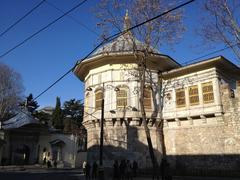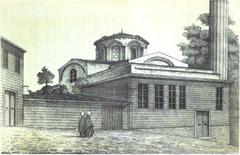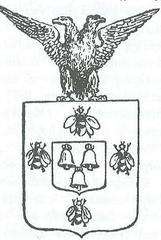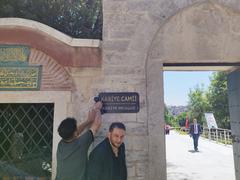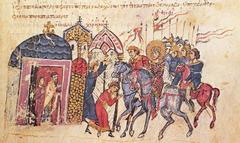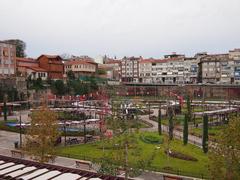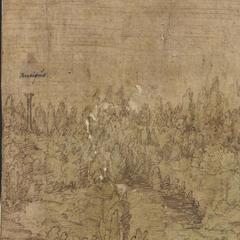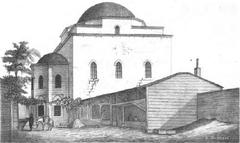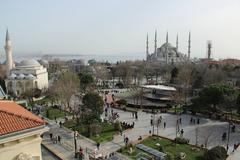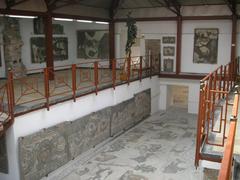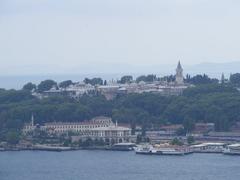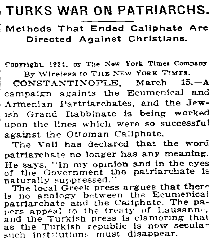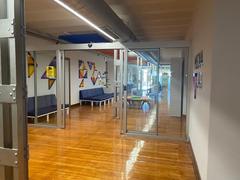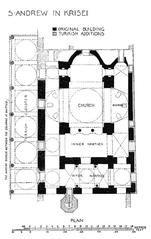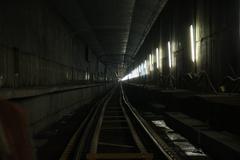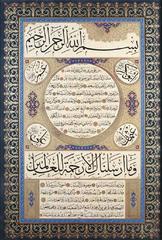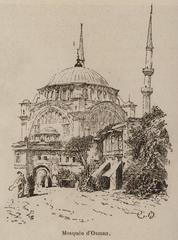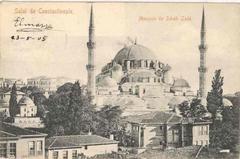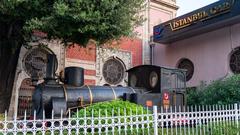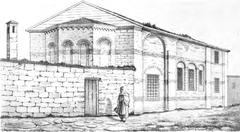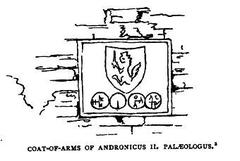Istanbul Carpet Museum: Visiting Hours, Tickets, and Complete Travel Guide
Date: 15/06/2025
Introduction: Istanbul Carpet Museum and Its Cultural Significance
Tucked into Istanbul’s historic Fatih district, the Istanbul Carpet Museum (Vakıflar Halı ve Kilim Müzesi) stands as a testament to Turkey’s centuries-old tradition of carpet weaving. Since its founding in 1979, the museum has safeguarded over 800 carpets and kilims dating from the 14th to the 20th centuries, each piece a vibrant thread in the tapestry of Anatolian, Ottoman, and Islamic cultural heritage. Many carpets were originally donated to mosques and religious foundations, embodying both religious devotion and social status. The museum not only preserves this artistry but also offers visitors a unique window into the spiritual, social, and artistic narratives woven into Turkish history (GuideTourism; Tribal Collections Blog).
Housed in the historic Almhouse (Imaret) of Hagia Sophia—an 18th-century Ottoman building—the museum enhances the visitor experience by merging architectural authenticity with modern conservation methods. Its three main galleries display carpets chronologically and thematically, featuring rare Seljuk, Holbein, and monumental Uşak carpets that reflect both local traditions and global influences (Nazmiyal Antique Rugs; Lonely Planet).
Turkish carpets serve as more than beautiful objects—they are symbolic of identity, status, and spirituality. Traditionally, they have functioned as portable homes for nomads, status symbols in Ottoman palaces, sacred prayer rugs, and diplomatic gifts bridging cultures (Albion Gould; Muslim Heritage; Istanbul Clues). Museum visitors gain insight into intricate motifs, weaving techniques such as the Ghiordes knot, and communal heritage sustained across generations.
Practical information on visiting hours, ticket prices, accessibility, and guided tours ensures a smooth experience. Located near iconic sites like the Hagia Sophia, Topkapı Palace, and Blue Mosque, the museum is ideally situated for cultural explorers (artandthensome.com; istanbul.tips). Interactive maps, audio guides, and virtual tours are available for deeper engagement (Tribal Collections Blog).
This guide prepares you to explore the Istanbul Carpet Museum, providing historical context, cultural insights, and all the practical details needed for an unforgettable visit.
Table of Contents
- Historical Origins of the Istanbul Carpet Museum
- Architectural Setting: The Almhouse of Hagia Sophia
- Collection and Historical Significance
- Visitor Information: Hours, Tickets, and Accessibility
- Conservation and Modernization Efforts
- The Museum’s Place in Istanbul’s Cultural Landscape
- Cultural Significance of Turkish Carpets
- Visiting the Museum: Hours, Tickets, and Tips
- Gallery Structure and Visitor Experience
- Practical Visitor Information
- Essential Nearby Historical Sites in Fatih
- Recommendations for a Memorable Visit
- Safety and Etiquette
- Useful Contacts and FAQ
- Summary and Visitor Recommendations
- References
Historical Origins of the Istanbul Carpet Museum
The Istanbul Carpet Museum was established on April 29, 1979, to preserve and showcase the rich tradition of Turkish carpet weaving, a practice deeply embedded in Anatolian and Ottoman culture. Many of the carpets in its collection were initially gifts to mosques and religious foundations, reflecting centuries-old customs (GuideTourism; Gezibilen).
Originally housed in the Hünkar Kasrı, a 17th-century annex of the Sultanahmet Mosque, the museum soon relocated to the larger Almhouse (Imaret) of Hagia Sophia, built by Sultan Mahmud I in the mid-18th century. This move improved preservation conditions and placed the museum in the midst of Istanbul’s most significant historical sites (Nazmiyal Antique Rugs; IamIstanbul).
Architectural Setting: The Almhouse of Hagia Sophia
The museum is set within the Almhouse of Hagia Sophia, an outstanding example of 18th-century Ottoman civic architecture that originally served as a public soup kitchen (Nazmiyal Antique Rugs). Its stone construction, spacious courtyards, and functional yet elegant design create a solemn, contemplative atmosphere.
Visitors enter through a striking baroque gate and explore three main galleries—formerly the dining hall, kitchen, and bakery—each now restored with modern climate control and conservation technology (Lonely Planet).
Gallery Layout and Highlights
- First Gallery (Dining Hall/Me’kel): Features the oldest Anatolian carpets from the 14th and 15th centuries, displayed in a space filled with natural light and high ceilings (Lonely Planet).
- Second Gallery (Kitchen/Aşhane): Showcases carpets from central and eastern Anatolia (15th–20th centuries) within stone-vaulted halls (Nazmiyal Antique Rugs).
- Third Gallery (Bakery/Fodlahane): Houses monumental Uşak carpets from the 17th and 18th centuries, dramatically displayed from floor to ceiling (Lonely Planet).
Each gallery is secured by electronically controlled double doors to maintain optimal conservation conditions (Nazmiyal Antique Rugs).
Collection and Historical Significance
The museum’s collection includes over 800 carpets and kilims representing regions such as Uşak, Bergama, Konya, Kula, and Hereke, as well as rare Turkmen, Persian, and Caucasian examples (IamIstanbul; GuideTourism). Notable highlights:
- Holbein Carpets: Geometric Anatolian carpets depicted in European Renaissance paintings (Lonely Planet).
- Uşak Carpets: Large medallion carpets, highly prized in both Ottoman and European courts.
- Prayer Rugs: Exquisite 19th-century examples from Kula, Gördes, Konya, Ladik, and Milas (Marmara Health).
- Mosque Carpets: Monumental pieces from the Süleymaniye and Blue Mosques.
Interpretive displays and interactive panels help visitors decode the symbolism and techniques of these masterpieces (Nazmiyal Antique Rugs).
Visitor Information: Hours, Tickets, and Accessibility
- Hours: Tuesday to Sunday, 9:00 AM–5:00 PM. Closed Mondays and public holidays.
- Tickets: 30–45 Turkish Lira for adults; discounts for students, seniors, children, and Museum Pass holders.
- Guided Tours: Available in several languages; book in advance.
- Accessibility: Wheelchair accessible, with ramps and elevators.
- Location: Fatih district, near Sultanahmet Square, Hagia Sophia, Topkapı Palace, and Blue Mosque.
- Getting There: Short walk from Sultanahmet tram stop; accessible via bus and taxi.
For current hours and ticketing, check the official museum website (artandthensome.com; istanbul.tips).
Conservation and Modernization Efforts
The museum has undergone extensive restoration, balancing historic integrity with advanced conservation technology. Climate-controlled galleries, selective exhibit rotation, and controlled lighting preserve the textiles for future generations (GuideTourism; Marmara Health).
The Museum’s Role in Istanbul’s Cultural Landscape
The museum’s strategic location places it at the heart of Istanbul’s historic peninsula, complementing nearby landmarks and enriching visitors’ understanding of the city’s cultural and artistic legacy (GuideTourism; Lonely Planet).
The Cultural Significance of Turkish Carpets
Symbolic and Social Role
Carpets are more than furnishings in Turkish and Islamic societies—they signify identity, status, and continuity. The tradition of weaving, introduced by nomadic Turkic tribes, evolved into an art form representing family heritage and social standing (Albion Gould). In Ottoman times, carpets became status symbols, with regions like Hereke and Uşak producing pieces for the imperial court (Istanbul Clues).
Motifs, Symbolism, and Storytelling
Motifs include geometric patterns (harmony and order), floral designs (paradise and renewal), medallions (imperial power or talismanic purpose), and animal figures (protection, strength). The distinctive Ghiordes knot allows for lasting and detailed patterns (Istanbul Clues).
Carpets in Trade and Diplomacy
From the 14th century, Turkish carpets were prized exports, appearing in Renaissance art and European palaces. They also served diplomatic functions as gifts from Ottoman sultans (Muslim Heritage).
Visiting the Museum: Hours, Tickets, and Tips
- Hours: Tuesday to Sunday, generally 9:00 AM–5:00 PM; some seasonal variation possible.
- Tickets: 30–45 TL for adults; discounts for students, children, Museum Pass holders. Tickets are available onsite and sometimes online.
- Facilities: Restrooms, gift shop, partial wheelchair access.
- Photography: Non-flash photography is typically allowed.
Visitor Tips:
- Visit early or late to avoid crowds.
- Use audio guides or join a guided tour for deeper context.
- Allocate 1–1.5 hours for the museum.
- Dress modestly due to proximity to religious sites.
- Enjoy nearby cafés for a complete cultural experience (istanbulinvestments.com).
Gallery Structure and Visitor Experience
Display and Conservation Features
- Climate Control: Electronic doors, controlled lighting, minimal windows.
- Security: Modern display cases and surveillance equipment.
- Interpretive Panels: Explanatory panels for motifs, weaving methods, and historical context (Tribal Collections Blog).
Interactive and Educational Elements
Digital kiosks, interactive maps, and multimedia displays enhance understanding. Restoration details and motif explanations are provided throughout.
Essential Nearby Historical Sites in Fatih
- Hagia Sophia: Adjacent UNESCO World Heritage landmark.
- Blue Mosque: Renowned for its blue İznik tiles.
- Basilica Cistern: Atmospheric subterranean reservoir.
- Turkish and Islamic Arts Museum: Complementary collection of Islamic art and carpets.
- Grand Bazaar and Spice Bazaar: Iconic markets for textiles and local goods.
- Süleymaniye Mosque, Fatih Mosque, Balat, Fener, Gülhane Park, Chora Museum, Yedikule Fortress: All within easy reach, offering further historical and architectural exploration (artandthensome.com; istanbulinvestments.com).
Recommendations for a Memorable Visit
- Combine your museum visit with the Turkish and Islamic Arts Museum.
- Shop for authentic carpets in the Grand Bazaar or local Fatih shops (worldofcarpetsbymustafa.com).
- Enjoy local cuisine and Turkish tea in Sultanahmet Square.
- Attend cultural performances like the Whirling Dervish shows.
- Use official taxis or public transit for convenience and safety (istanbul.tips).
Safety and Etiquette
- Keep belongings secure; be mindful of pickpockets.
- Dress respectfully in religious sites.
- Use official transportation options.
Useful Contacts and FAQ
Tourist Information: Sultanahmet Square and main transport hubs
Emergencies: 112 (medical), 155 (police)
Frequently Asked Questions
- Q: What are the visiting hours?
A: Tuesday–Sunday, 9:00 AM–5:00 PM (verify for holidays/seasonal changes). - Q: How much are tickets?
A: 30–45 TL for adults, with discounts available. - Q: Is the museum wheelchair accessible?
A: Mostly, though some areas may have steps. - Q: Are guided tours offered?
A: Yes, in multiple languages. - Q: Can I take photos?
A: Non-flash photography is generally permitted.
Summary and Visitor Recommendations
The Istanbul Carpet Museum is a vital institution for anyone interested in Turkish culture, showcasing centuries of weaving artistry within the historic Almhouse of Hagia Sophia. Its thoughtfully curated galleries, advanced conservation, and educational resources make for a rewarding visit. Strategically located near Istanbul’s major historical sites, it offers a deep dive into the social, religious, and diplomatic roles of carpets in Turkish life (GuideTourism; Lonely Planet; Albion Gould; Muslim Heritage).
For enhanced experience, check for updates on hours and tickets, and take advantage of guided tours and digital resources. Pair your visit with exploration of Fatih’s historical gems for a comprehensive cultural itinerary. For ongoing updates and interactive guides, download the Audiala app and follow on social media.
References
- GuideTourism - Istanbul Carpet Museum
- Tribal Collections Blog - The Carpet Museum in Istanbul
- Nazmiyal Antique Rugs - Istanbul Carpet Museum
- Lonely Planet - Carpet Museum
- Albion Gould - Rugmaking in Turkey
- Muslim Heritage - The Muslim Carpet
- Istanbul Clues - Turkish Carpets History
- artandthensome.com - Places to Visit in Fatih
- istanbul.tips - Istanbul Travel Tips
- Marmara Health - Carpet Museum
- IamIstanbul - Carpet Museum
- Gezibilen - Vakiflar Hali ve Kilim Muzesi
- Private Istanbul Guide - Istanbul Carpet Museum
- homeandrugs.com - Exploring the Carpet Museum of Istanbul
- istanbulinvestments.com - Top 15 Things to See and Do in Fatih
- worldofcarpetsbymustafa.com - Fatih Handmade Carpet
- turkeyvisaonline.com - Guide to Must-See Attractions in Fatih
- en.gezimaks.com - Fatih
For images, consider alt text such as “Istanbul Carpet Museum exterior,” “Historical carpets on display,” “Almhouse architecture,” and “Visitors exploring Istanbul Carpet Museum” to enhance accessibility and SEO.
